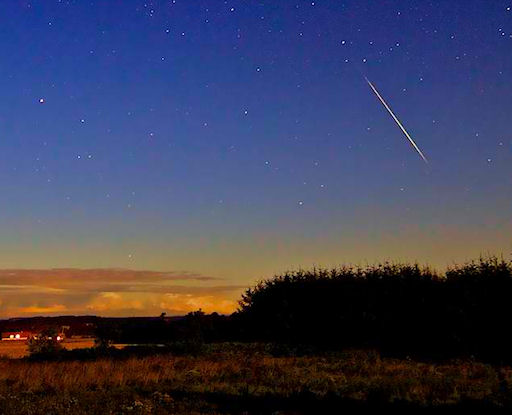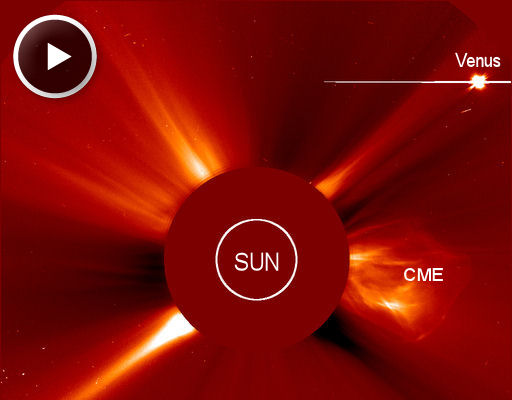They came from outer space--and you can have one! Genuine meteorites are now on sale in the Space Weather Store. | | |
PERSEID METEOR SHOWER: Earth is entering a stream of debris from Comet Swift-Tuttle, source of the annual Perseid meteor shower. International observers are now reporting more than 20 Perseids per hour, a number that will increase as the shower reaches its peak on August 12-13.
"Last night I witnessed a large and colorful Perseid over my home in Silkeborg, Denmark," reports photographer Jesper Grønne. A close-up of the meteor shows its vivid color.

John Chumack of Dayton, Ohio, adds this report: "Last night between 10 pm and 6 am I recorded more than 100 meteors using various sky cameras mounted on top of my home and backyard observatory. Moonlight is not preventing us from seeing the bright ones!" He compiled a timelapse slideshow of highlights. "Note how my dome rotates during the observing session," he points out.
The best time to look is Saturday morning, Aug. 13, just before dawn when the Moon is low and meteor rates are peaking. Some observers will also see the International Space Station, which coincidentally flies over many US towns and cities during the shower's peak: ISS tracker. Also, be sure to tune into Space Weather Radio to hear the ghostly pings of Perseids disintegrating over the US Air Force's Space Surveillance Radar. It makes a great soundtrack for any meteor watch.
 What sat was that? The hours before dawn are a great time to see satellites. There are hundreds in Earth orbit, and you're sure to spot some of them while you're watching the Perseids. Your Android phone can tell you which ones you're seeing: Download WhatSat.
What sat was that? The hours before dawn are a great time to see satellites. There are hundreds in Earth orbit, and you're sure to spot some of them while you're watching the Perseids. Your Android phone can tell you which ones you're seeing: Download WhatSat.
more Perseid images: from David Blanchard of Flagstaff, Arizona; from Marco Langbroek of Leiden, the Netherlands; from Aaron Top of Shallow Lake Ontario Canada; from Torcuill Torrance of Stonehaven, Scotland, UK
PARTING SHOTS: Active sunspot 1263, which just two days ago produced the most powerful solar flare of the new Solar Cycle (an X7), has left the Earthside of the sun. It is now beginning a two week transit across the solar farside. We can still see signs of its ongoing activity, however. On August 11th, an eruption from sunspot 1263 hurled a bright CME over the sun's western limb:

For the next two weeks (the time it takes to transit the sun's farside) no blasts from sunspot 1063 will be Earth directed. For the next few days, however, we could see a few more parting shots. Readers with solar telescopes are encouraged to monitor developments.
TODAY'S BONUS SHOTS: Flying Spectrum from Dave Eagle of Higham Ferrers, England; Michigan Auroras from T. Scott Blankinship of Paradise, Michigan; Dark Rays from Ugur Ikizler of Mudanya - Bursa / Turkey; Striped Sunset from Marie Hall of Bridgeport, Ny
August 2011 Aurora Gallery
[previous Augusts: 2010, 2009, 2008, 2007, 2006, 2005, 2004, 2003, 2002]
2011 Noctilucent Cloud Gallery
[previous years: 2003, 2004, 2005, 2006, 2007, 2008, 2009]

